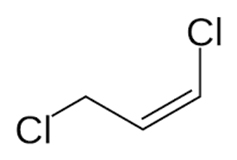 What is 1,3-Dichloropropene?
What is 1,3-Dichloropropene?
1,3-Dichloropropene appears as a clear colorless liquid. Flash point 95°F. Denser (at 10.2 lb / gal) than water and insoluble in water. Vapors are heavier than air.
Uses
1,3-Dichloropropene is the predominant component of several formulations used in agriculture as soil fumigants for parasitic nematodes.
Sources & Potential Exposure
1,3-Dichloropropene is used as a component in formulations for soil fumigants. Acute (short-term) inhalation exposure of humans following a spill caused mucous membrane irritation, chest pain, and breathing difficulties. Effects on the lung have been observed in rats acutely exposed to 1,3- dichloropropene by inhalation. Chronic (long-term) dermal exposure may result in skin sensitization in humans. Damage to the nasal mucosa and urinary bladder are the primary health effects of rodents chronically exposed to 1,3-dichloropropene by inhalation. Information on the carcinogenic effects of 1,3- dichloropropene in humans is limited; two cases of histiocytic lymphomas and one case of leukemia have been reported in humans accidentally exposed by inhalation to concentrated vapors during cleanup of a tank truck spill. An increased incidence of bronchioalveolar adenomas has been reported in male mice exposed by inhalation but not in rats or female mice. Workers may be occupationally exposed to 1,3-dichloropropene, dermally or by inhalation, during its manufacture, formulation, or application as a soil fumigant. The general public may be exposed via inhalation near source areas or from the consumption of contaminated drinking water from wells near some hazardous waste sites.
Federal Regulations
EPA has classified 1,3-dichloropropene as a Group B2, probable human carcinogen.

 Americas
Americas Europe
Europe Français
Français Deutsch
Deutsch Italiano
Italiano Español
Español



